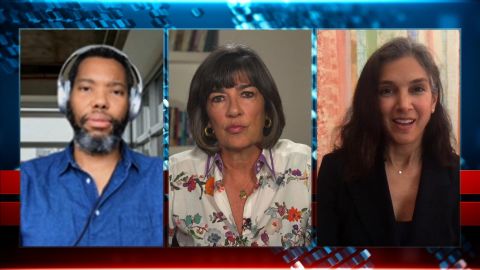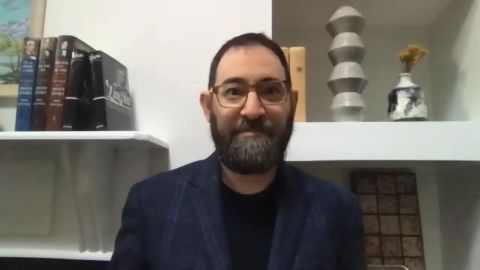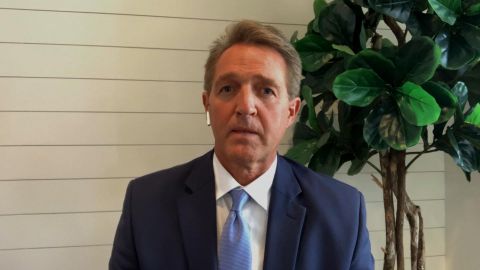Read Transcript EXPAND
CHRISTIANE AMANPOUR: Now, earlier, you heard former Senator Jeff Flake, a self-proclaimed Reagan conservative. Well, historian and journalist Rick Perlstein has been called the chronicler extraordinaire of American conservatism. His new book, “Reaganland,” the latest in a series exploring how conservative politics came to dominate American politics, retraces the events that propelled Ronald Reagan to the White House. And he tells our Walter Isaacson how it compares to President Trump’s vision.
(BEGIN VIDEOTAPE)
WALTER ISAACSON: Thanks, Christiane. And, Rick Perlstein, welcome to the show.
RICK PERLSTEIN, AUTHOR, “REAGANLAND”: Thank you. Glad to be here.
ISAACSON: You have written now this fourth book on the rise of the new right in America. Tell me, how is what’s happening now with Donald Trump, how does that resemble what happened with the rise of Ronald Reagan?
PERLSTEIN: Well, I like to say history is a process that parallels. And the process that produced Donald Trump were forged in this crucible of the movement that gave us Ronald Reagan. I was really struck looking through my book the other day at a quote that Pat Robertson, the televangelist who eventually, of course, ran for president as a Christian right candidate, what he said in 1978. He said: “God wants stability. It’s better to have a stable government under a crook than to promote turmoil under an honest man,” right? So, in that sense, you can clearly see that there’s nothing surprising that a movement like that would be galvanized by a Donald Trump, if they believe that they’re kind of getting what they want in terms of society of hierarchy and authority and all the usual right-wing values. But, by the same token, Donald Trump and Ronald Reagan were very different people. Of course, Ronald Reagan cherished immigration. When he gave his speech introducing his campaign for the primary in 1979, he proposed open borders between the United States and Mexico. But, certainly, the forces that brought him to the Republican nomination and then the presidency were full of the same sort of feral, reactionary rage that we see as the hallmark of the Trump era.
ISAACSON: Well, let’s start with those things that you have said were differences. To me, I covered the Ronald Reagan campaign when I was a reporter. And he seemed to exude optimism, a genuine sense of sunniness.
PERLSTEIN: Right. Right. He did. And that was absolutely crucial to his appeal. It’s something he really introduced into conservative rhetoric, which sounded before Ronald Reagan became its dominant force a lot like the kind of American carnage rhetoric we hear from Donald Trump. And he was extremely skilled at making public presentations that created a sense of comfort and ease, but often around the same sort of policies and the same sort of attempted outcomes as the more kind of feral and angry and rageful conservatism was calling for. And so he was — he was adapted by the people who, for example, were weaponizing fear and anger about gay rights, right, even though he did not express that fear in anger in anything like the same unsavory terms.
ISAACSON: One of the things that struck me in your book, because I was there, the Neshoba County Fair in Mississippi. Ronald Reagan famously gives a speech in which he’s in the environment with the Klan and racism and the murders of civil rights workers had happened, and it was supposed to be a bit of red meat for his followers. And yet he was oddly uncomfortable giving it. It was the worst speech he ever gave.
(CROSSTALK)
ISAACSON: That’s sort of in your book.
PERLSTEIN: Right. His strategists knew that if he was perceived as a bigot that he wouldn’t be able to win those kind of swing voters, those moderate voters. And they made it absolutely central to his campaign for him to speak to as many African-American audiences as possible. In fact, the campaign was not supposed to open at the Neshoba County Fair. It was supposed to open at the Urban League Convention, the African-American civil rights organization in New York. There was a schedule snafu. The Neshoba County Fair, down the street from where three civil rights workers were lynched in 1964, ended up being the opening of the campaign. And the guy who picked him up at the airport was a young congressman, the chairman of his Mississippi campaign, Trent Lott. And he said, you can really win over this audience if you mention states’ rights, which, of course, was the sort of thing that racists have been using to advance the cause of white supremacy for generations in Mississippi. And Reagan takes his advice. But you can tell that he’s uncomfortable with it, right? His most powerful psychological wellspring, really the foundation of his self-image, was that he was not — he was a figure of innocence. He was not an aggressive person, right? So the way — the best way to kind of make Ronald Reagan lose his temper to accuse him of racism. So, you can see him delivering the speech, telling the usual jokes and stories that he tells, but he doesn’t really stop telling the jokes and stories. He just keeps on going on and on. And, finally, he makes his turn to his usual anti-government rhetoric, and he gets to this. And you can kind of feel the audience kind of draining away. And, immediately afterwards, Jimmy Carter pounces, right? And he’s accused by a group of Southern governors, Southern Democratic governors of being a carpetbagger. And the most fascinating document I was able to read was one in which an official of the Mississippi Democratic Party said, we had a chance for a landslide in Mississippi. But, basically, people in Mississippi don’t want to be seen as the butt of the nation’s derision for their racial past, and now it’s a tossup. There was actually a backlash against Reagan’s backlash politics. That’s another example in which we see that kind of difference between Ronald Reagan and Donald Trump. Often, the policy goals are the same. But Reagan was very good at selling them with a smoothness and kind of a domesticated anger. And just as an example of just how skilled he was, by the November election, he manages to win the endorsement of Martin Luther King’s right hand-man, Ralph Abernathy. Martin Luther King died in his arms. And he gave a rip-roaring speech for Ronald Reagan in a black church in Detroit a couple of weeks before the election.
ISAACSON: What’s interesting to me is that Jimmy Carter was the first evangelical Christian to be elected president.
PERLSTEIN: Right.
ISAACSON: Does very well with the evangelical vote. And then quickly, within four years, the evangelical vote switches sides. Why is that?
PERLSTEIN: Yes. Jimmy Carter has a very old-fashioned and traditional sense of how a Southern Baptist should enter the public sphere, which was with a reluctance to bring his religion into political discussions, right? In fact, when he gives his famous interview in “Playboy” magazine, which is really the most deep, brilliant, thoughtful, interesting portrait of the mind of a presidential candidate we had ever seen, that’s specifically what he’s trying to convince his readers. When he wanders into this theological disposition, he says, I’m not going to be breaking down people’s doors. He’s not going to break down fornicators’ doors, he says, and that segues into the discussion that begins when the interviewer, Robert Scheer, asks him if he’s afraid of being assassinated. And he immediately takes that into a very deep place. And he says, no, me and Rosalynn are not afraid of death because we have been washed in the blood of the lamb. We believe in the hereafter. And that’s when he starts talking about how he has lusted in his heart many times, but he knows that God has forgiven him. And the media does a terrible job with this. They immediately turn this into a giant joke. And that’s when you begin to see the evangelicals taking a hard second look at him. This is a guy who is not reading fundamentalist theologians. He’s reading Reinhold Niebuhr. This is not a guy who’s listening to Anita Bryant. He’s listening to Bob Dylan. He’s speaking warmly of the Equal Rights Amendment. And the rest of the Southern evangelical movement, along with the rest of Christian fundamentalism, is making a turn towards politics in which those divisive social issues, those issues that have to do with kind of the social mores of the 1960s kind of entering the mainstream of American life, are becoming their political focus, this very apocalyptic fear that liberalism is taking over. And they begin to associate Jimmy Carter with those fears, such that, by 1980, they’re treating Jimmy Carter like he’s Beelzebub.
ISAACSON: The trajectory of your four books begins with the rise of Goldwater. But Goldwater gets wiped out in a massive landslide, ceding the ground in some ways for Ronald Reagan, who endorses him with a speech.
PERLSTEIN: Right.
ISAACSON: How did that trajectory from the defeat of Goldwater so badly ended up with landslide victories for Reagan not too much later?
PERLSTEIN: Well, the process begins very soon after that, right? So my first book, “Before the Storm,” ends with all the pundits declaring the Republican Party dead and buried unless they purge conservatives, because there’s been such a mandate for liberalism. But only two years later, a lot of the people who lost office because liberals won on Lyndon Johnson’s coattails got back in office. Ronald Reagan wins the election in 1966. And a lot of this is the racial backlash against what’s happening in the streets. And a lot of this is the backlash against kids protesting against the Vietnam War. Pundits are always declaring conservatism a dead letter in American politics after liberals win, and it never is, right? It always kind of comes back, like the monster in a Godzilla movie, you know? And the process I described in all these books is the weaponization of the fear and the resentment, the anxieties about the social changes that are happening in America that eventually become accepted parts of American life. But when they are introduced to the scene, like, the idea that gays and lesbians should have the same rights as everyone else, they’re terrifying, right? And you can kind of use that terror to kind of frighten people into voting for candidates who come into office and do things like cut taxes for corporations, right? So that’s a playbook that they have run again and again and again that reaches its modern apotheosis with Ronald Reagan, and has kind of been repeated again and again, possibly with diminishing returns in 2020.
ISAACSON: Let me push back on something you just said, which is that conservatism keeps roaring back like a monster. Why is it a monster, in the sense it is tapping into things that people deeply feel and that liberals…
(CROSSTALK)
PERLSTEIN: Let me address that very important question. If you look at Arthur Schlesinger’s history of the New Deal, and you read what conservatives were saying in the middle of the 1930s, when Social Security was first propounded, they said it’s going to destroy freedom in the United States. If you look at what Ronald Reagan said when Medicare was first propounded in 1961, and he recorded a medical — a record album for the American Medical Association to lobby against it, he said, if this passes, if old people get to get free health care out of Social Security, we will be telling our children’s stories about what America was like when it was free. You heard the same thing about what happens if African-Americans are afforded full right — full civil rights in the South in 1964, the same thing you heard in 1977 in 1978 about whether gay Americans receive full civil rights. It happens that the changes are frightening at first, but we eventually accept them as part of Americans’ birthright as a free and equal nation. The next time some social change is proposed by liberals, you will see the same panic, right, whether it’s Arab Americans become American life, and then there’s a terror over Sharia law. But the same pattern repeats itself, but the world doesn’t end. That’s the way the politics of reaction works. And we kind of divide the humanist state of people figuring out politics and built a left wing and a right wing. And the left wing are the people who have their own flaws, but generally are more comfortable with expanding the ambit of freedom and liberty. And the right wing are the people who kind of use the fears over those changes in order to kind of gain and control power. And I think it’s reached its apotheosis with Donald Trump. We have seen how dangerous and how ugly that can be when it kind of reaches its kind of most pure ore.
ISAACSON: But don’t you think the liberals are somewhat to blame for not understanding and not even feeling the true resentment and perhaps even understandable resentments people feel about the way the economy and, for that matter, foreign policy has been conducted?
PERLSTEIN: Well, the Democrats, I think, certainly at their convention that we just saw have kind of shown themselves to be a pretty pluralist party. You did have this priest kind of praying for the unborn in the womb, at the same time as you saw very strong pro-choice elements, whereas the Republicans refused to have a platform. They basically just said, our platform is supporting Donald Trump, right? So, I mean, there’s nothing wrong with being a conservative, right? And there’s nothing wrong with respecting the fears that people have about social change. I think the challenge of leadership in a diverse and pluralist society is to respect the necessity of change, but also kind of calm people’s fears about anxieties that change brings.
ISAACSON: What about the weaponization of resentment? How important is resentment in the rise of the new right?
PERLSTEIN: It’s absolutely crucial. That’s the theme of my book “Nixonland,” in which the figure at its center, Richard Nixon, basically forms a social club for all the nerds in his college and kind of weaponizes their resentment against the cool kids, who are in the fancy fraternity. And that becomes his political template. The nerds in his college fraternity become the silent majority in his famous speech of 1969, right? It’s Sarah Palin talking about how all these kind of cosmopolitan intellectuals are trying to tell you that they’re more moral and more smart than you are, but, really, you’re the smart one, right? So that sort of resentment at liberal cultural elites, as opposed to the resentment that the Democrats have traditionally mobilized for the working class, and their resentment of their bosses, who are kind of telling them what to do at the workplace, is absolutely central to conservatism becoming a popular and not an elite movement — movement, I should say.
ISAACSON: Reagan used to use the old John Winthrop line about a city on a hill, a shining city on a hill.
PERLSTEIN: Right.
ISAACSON: And that was a sense of the belief in America. Why has that changed in the era of Donald Trump?
PERLSTEIN: Yes, that’s really a fascinating quotation, because, in the hands of Ronald Reagan, it’s actually 180 degrees the opposite of John Winthrop intended. When he said, we’re going to be a shining city on the hill, he meant everyone’s going to be looking at us, so we really have to hold ourselves to a much higher standard of moral virtue. Ronald Reagan meant it as, we’re already a standard of moral virtue, and anyone who disagrees is maybe not quite American at all. It’s really central to Ronald Reagan’s appeal that he absolves America of their sins, right? He says America is not racist, America is a force for good in the world, and it’s these liberals who are kind of trying to apologize for America that are the problem. Jimmy Carter is the guy who says we need to make do with less, we have to sacrifice. Ronald Reagan is the guy who says, no, America — the American economy is this mighty dynamo, and the only reason it’s not performing at full capacity is that these liberals, liberal regulators have their foot on its neck, and I’m going to release that. I’m going to give a tax cut to everybody. Right? So the idea of the city on the hill, in the hands of Ronald Reagan, is a way of telling Americans that they don’t need to kind of challenge themselves to a higher and more vigorous standard of patriotism, patriotism is all about worshipping and celebrating this essential greatness of America that can only be befouled by foreign elements, like liberalism, like bureaucrats.
ISAACSON: Rick Perlstein, thank you so much for joining us.
PERLSTEIN: Thanks for your kind hospitality, Walter.
About This Episode EXPAND
Christiane speaks with former Republican Sen. Jeff Flake about why he’s voting for Joe Biden. She also speaks with Radhika Jones and Ta-Nehisi Coates about how Vanity Fair is dedicating itself to “art, activism, and power in 21st century America.” Walter Isaacson speaks with historian Rick Perlstein about how conservative politics rose in America.
LEARN MORE


